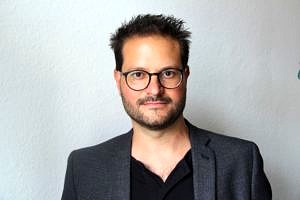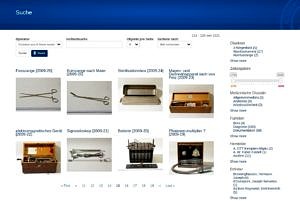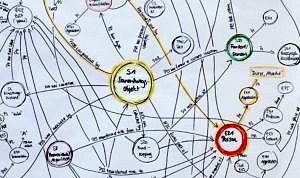Digital browsing, strolling and researching

Digitization of six FAU collections.
What does the digital age mean for scientific collections? FAU and the Germanisches Nationalmuseum addressed this question in their joint research and digitization project “Objekte im Netz”.
Antique coins, medieval musical instruments, prepared body parts, zoological models or valuable drawings – many a treasure slumbers in museums and scientific collections all over the world. Far back in the depot, deep down in the cellar, up in the attic. Because only a fraction of the objects can be permanently exhibited and made accessible to science and the public. “Digitization opens up completely new possibilities for us here, we just have to use them productively and successfully,” says Udo Andraschke, head of the central custody department at FAU. He knows what he is talking about, because the university and the Germanisches Nationalmuseum (GNM) have just completed the project “Objekte im Netz”, which was funded by the Federal Ministry of Education and Research with 553,000 Euros, and have developed their own central portal where the FAU collections are networked and can be searched across holdings.

Digital transfer zone
For three years, the two institutions worked together on the project and selected six FAU collections: the Graphic Collection of the University Library, the Medical Collection, the Palaeontological Collection, the Pre- and Early History Collection, the School History Collection and the Collection of Musical Instruments. The latter was transferred to the University of Würzburg in 2010 with the amalgamation of the musicological seminars. “These collections have been catalogued to varying degrees and differ greatly in terms of the materiality, function and origin of their objects,” explains Andraschke. The advantage is obvious: If the researchers succeed in systematically recording these very different collections, making them digitally accessible and networking them with one another, the results can also be transferred to other university collections. And there are around 1,100 of these “cabinets of knowledge” in Germany, distributed among over 80 universities. The FAU alone owns around 25 collections with numerous objects from a wide variety of disciplines and was one of the first universities in Germany to establish a central custody in 2011. Since then, Udo Andraschke has been taking care of the collection holdings.
“Collections have always had great creative potential. They have always been places of encounter, of movement, of exchange – in other words, transfer zones,” explains Andraschke. “But it is only through virtual collection spaces that researchers – and a global public – can stroll in them day and night, research objects or simply browse and discover them. Only through digital transfer zones and virtual research environments can the visibility and availability of objects in scientific collections be increased. And the possibilities for interaction are often much more diverse in virtual space than in analog – in line with the Science Council’s objectives (see box). “In the digital collection space, we can deal with objects in a completely different way, relate them to one another – or we are even made aware of such relationships,” says Andraschke. “For scientific collections, this is a completely new opportunity to conduct up-to-date research with the often old holdings. That’s why it is particularly important to the curator that the digitization of the collections continues even after “objects on the net”.
The joy of discovery

But how do the analog objects get on the net? The technical basis of the research and digitization project is the virtual documentation environment WissKI. The abbreviation stands for Scientific Communication Infrastructure and is a software specially designed for the indexing, research and publication of cultural heritage. It was developed in two DFG research projects in which both FAU and GNM were significantly involved. “We have been using the browser-based WissKI software successfully for many years for digital documentation in the museum sector”, says Mark Fichtner, research associate at the GNM, and responsible for the technical part in the joint research project. Together with two colleagues and several assistants, the computer scientist further developed the WissKI software into a virtual collection space based on the FAU collection holdings and everyday work processes.

To this end, Fichtner and Andraschke’s research team initially sought intensive dialogue with colleagues from the museum, the collections and the Digital Humanities Master’s program. In the next step, the team designed a data model with which the holdings can be catalogued, researched, networked and published. The model consists of around 90 so-called classes – these are description units such as “physical object” or “person”, and 150 properties with which the objects can be described in a uniform way. In addition, the information is embedded in the context of events – such as discovery, production, invention, acquisition or restoration -, located in time and space, and linked to involved actors. “This concept goes far beyond a mere inventory by digital means”, Fichtner emphasizes. “It creates a variety of interfaces – and the more objects are captured in the collection space, the greater the network of relationships within and between the collections. Complex research queries and diverse search paths are possible”. And thanks to a number of interactive elements, users of virtual collections can view, rotate, zoom in and compare the digitized objects from different perspectives. In other words, a completely different approach to and access to objects, made possible by the toolkit of digital technology and the World Wide Web.
“We support the joy of research and discovery,” Udo Andraschke is sure. And it is a very important element of scientific collections for the central custodian of FAU. “By browsing, strolling and discovering digitally, we often find something we were not even looking for. And then we ask new questions, broaden our research horizon and gain new insights. No matter whether it is ancient coins, zoological models or valuable drawings.
More info:
http://objekte-im-netz.fau.de/projekt/
Taken from the blog “FAU aktuell“.
